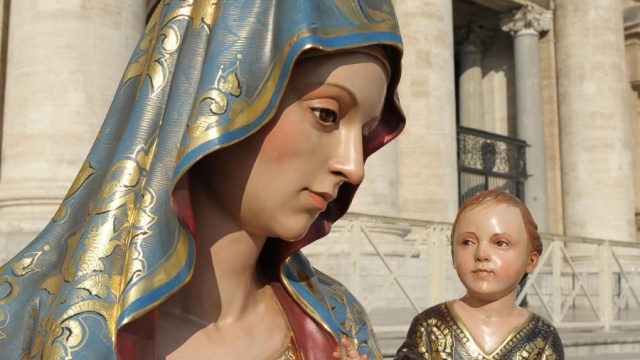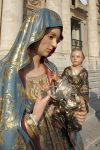

Deacon-structing Mary - Part 5: Mary in the Americas
Deacon Pedro
Sunday, September 18, 2016

Last week we looked at some Marian apparitions and I wondered why Mary has so many names. It's the same Mary, no? I guess, part of it is that we like to appropriate Mary, make her our own. Of course, as a Latino, I can't think of Mary without thinking of our Latin American church. Had you asked me when I was growing up though, it would never have occurred to me to say that the Latin American Church was a ‘Marian’ Church.
But when most of your friends are named Maria de Lourdes, Maria Angélica, Maria de los Ángeles, Maria Alejandra, Maria Lorena, Maria del Pilar, Maria Eugenia, Maria Teresa, Maria del Carmen, or simply Lourdes, Carmen, Pilar or Guadalupe, you have to wonder where this comes from. No one can deny that a devotion to Mary is the most popular characteristic of Catholicism in Latin America.
When I first started reflecting about this I thought that this devotion began with the apparitions of Our Lady of Guadalupe in Mexico. After all, Mary of Guadalupe is responsible for the conversion of some 10 million Aztecs to Catholicism. But what is it about Mary that made so much sense to the native Mexicans and to native peoples throughout the continent?
When the Spanish and Portuguese first came to the continent in the late 15 century, they brought traditions that were dear to them. History shows that almost to the man, they had devotions (or superstitions) to the Virgin Mary. One story is that of conquistador Vasco Núñez de Balboa who, some 25 years before the apparitions of Guadalupe, founded the settlement of Santa María La Antigua del Darién. St. Mary the Ancient was an image venerated in Seville and a banner with the image had been brought across the Atlantic by Balboa. The native chief Cémaco threatened battle and the Spaniards vowed to Santa María that they would name a settlement after her if they defeated the attackers. Needless to say, the Spanish were victorious.
The image is generally represented by Mary who carries the child Jesus on one arm. Jesus is playing with a little bird. In her other hand, Mary has either a sceptre or a thornless rose. Although it is a sweet depiction of the Madonna and Child, the image does not gain its devotion because of its sweetness, but because of the Moorish wars in Spain. Various legends at the time of El Cid recount the image’s miraculous powers to win battles.
According to legend, this devotion began when King Fernando attempted to retake Seville and had a vision of an angel who guided him to penetrate the city all the way to the mosque. When he did, one of the walls of the mosque turned to glass, and behind it appeared the image of Our Lady of la Antigua. A few days later the Moors surrendered. The first thing the King did was return to the mosque to rescue the image and an ancient church was found buried under the mosque. The image had survived centuries under the Muslims. The Cathedral of Seville is built on that same site, and that is where the original image rests to this day.
From that moment, Santa Maria de la Antigua was enlisted to accompany the crusaders in all their battles. In every town that was taken, the mosques were converted into churches, and the first image that entered the new church was the image of the Virgin of Antigua. This is why the explorers, beginning with Columbus looking for a new route to the Indies, brought her along. The intercession of Mary that led the Spaniards to drive away the Moors also helped them conquer the New World.
So why did the image of Mary become so popular with the indigenous people of the Americas who were being conquered? Some scholars will say that it is because the Natives could relate to the image of a goddess or the idea of the earth as mother. Others will say that it is because there is a connection between oppression and maternity and Mary is the perfect image to offer comfort to the oppressed. Perhaps it is because of the influence of Our Lady of Guadalupe or perhaps Guadalupe had so much influence because of these reasons. No one can know for sure. What is certain is that at some point Mary went from being a conqueror to being a liberator. Maybe that is the transforming power of Guadalupe.
Two hundred years later, Latin American liberators also took the mantle of Mary when fighting for their independence from Spain and Portugal. South American liberator General San Martin named the Virgin of Carmel “general” of his army before crossing the Andes. And it is well known that one of the first things Simón Bolívar used to do when arriving in Chiquinquirá would be to visit the image of Our Lady.
Today, every single country in the continent has Mary as a patroness, venerated under a different name (see below). For all people of the Americas, Mary is no longer mother of the conquerors but mother of the poor, the captives, and of the exiles. She is comforter; a liberator and mother of the oppressed. She is the Virgin of hope.
 Santa Maria la Antigua is the patroness of Panama and her name and image can be found all over the American continent; Islands, chapels, churches, schools and universities are named after her. In 2013 Panama celebrated the 500th anniversary of Santa Maria la Antigua (now Panama City) being named first diocese on main land.
Santa Maria la Antigua is the patroness of Panama and her name and image can be found all over the American continent; Islands, chapels, churches, schools and universities are named after her. In 2013 Panama celebrated the 500th anniversary of Santa Maria la Antigua (now Panama City) being named first diocese on main land.
 Every week, Deacon Pedro takes a particular topic apart, not so much to explore or explain the subject to its fullness, but rather to provide insights that will deepen our understanding of the subject. And don’t worry, at the end of the day he always puts the pieces back together. There are no limits to deaconstructing: Write to him and ask any questions about the faith or Church teaching: [email protected]
Every week, Deacon Pedro takes a particular topic apart, not so much to explore or explain the subject to its fullness, but rather to provide insights that will deepen our understanding of the subject. And don’t worry, at the end of the day he always puts the pieces back together. There are no limits to deaconstructing: Write to him and ask any questions about the faith or Church teaching: [email protected]
Mary across the Americas Argentina - Our Lady of Luján Bolivia - Our Lady of Copacabana Brazil - Our Lady of Aparecida Chile - Our Lady of Carmel of Maipú Colombia - Our Lady of Chiquinquirá Costa Rica - Our Lady of the Angels Cuba - La Virgen the Caridad del Cobre Dominican Republic - Nuestra Señora de las Mercedes Ecuador - Our Lady of Quinche El Salvador - Our Lady of Peace Guatemala - Our Lady of the Rosary Honduras - La Virgen de Suyapa Mexico - Our Lady of Guadalupe Nicaragua - Our Lady of "El Viejo" Panama - Santa María La Antigua Paraguay - Our Lady of Caacupé Peru - Our Lady of la Merced Puerto Rico - Our Lady of the Divine Providence Uruguay - La Virgen de los Treinta y Tres Venezuela - Our Lady of Coromoto United States - Immaculate Conception Canada - Mary of the Hurons, Our Lady of the Cape- Read all my posts about Mary: Deacon-structing Mary Part 1: Full of Grace Deacon-structing Mary Part 2: The Assumption Deacon-structing Mary Part 3: The Rosary Deacon-structing Mary Part 4: Apparitions Deacon-structing Mary Part 5: Mary in the Americas Deacon-structing the Hail Mary Image:
 Santa Maria la Antigua is the patroness of Panama and her name and image can be found all over the American continent; Islands, chapels, churches, schools and universities are named after her. In 2013 Panama celebrated the 500th anniversary of Santa Maria la Antigua (now Panama City) being named first diocese on main land.
Santa Maria la Antigua is the patroness of Panama and her name and image can be found all over the American continent; Islands, chapels, churches, schools and universities are named after her. In 2013 Panama celebrated the 500th anniversary of Santa Maria la Antigua (now Panama City) being named first diocese on main land.
 Every week, Deacon Pedro takes a particular topic apart, not so much to explore or explain the subject to its fullness, but rather to provide insights that will deepen our understanding of the subject. And don’t worry, at the end of the day he always puts the pieces back together. There are no limits to deaconstructing: Write to him and ask any questions about the faith or Church teaching: [email protected]
Every week, Deacon Pedro takes a particular topic apart, not so much to explore or explain the subject to its fullness, but rather to provide insights that will deepen our understanding of the subject. And don’t worry, at the end of the day he always puts the pieces back together. There are no limits to deaconstructing: Write to him and ask any questions about the faith or Church teaching: [email protected]
Related Articles:
<<













